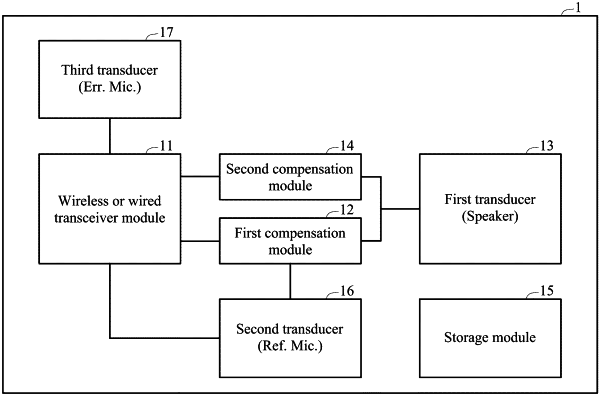| CPC G10K 11/17854 (2018.01) [H04R 1/1016 (2013.01); H04R 1/1083 (2013.01); G10K 2210/1081 (2013.01); G10K 2210/3028 (2013.01); G10K 2210/3056 (2013.01); H04R 2420/07 (2013.01); H04R 2460/01 (2013.01)] | 15 Claims |

|
1. An earphone device, comprising:
a wireless or wired transceiver module configured to receive a first electrical signal from an electronic device via a wireless or wired transmission network;
a first compensation module connected to the wireless or wired transceiver module and arranged in a streaming audio gain compensating filter of an active noise cancellation chip, wherein the first compensation module is used to implement a frequency response curve to calculate a frequency response of the first electrical signal in each frequency band, and to generate a first filter parameter of a target frequency response curve via a first compensation gain conversion model, and wherein the first filter parameter gain compensates the first electrical signal in each of the frequencies;
a first transducer connected to the first compensation module and/or the wireless or wired transceiver module, wherein the first transducer converts the gain-compensated first electrical signal into a sound when enabling a compensation function, so as to transmit the sound, and directly converts the first electrical signal into a sound when disabling the compensation function so as to transmit the sound;
a second transducer connected to the first compensation module, wherein the second transducer receives a first test signal from the electronic device and converts the first test signal into a third electrical signal; and
a third transducer connected to the wireless or wired transceiver module, wherein the third transducer synchronously converts the transmitted sound into a fourth electrical signal, so as to transmit the fourth electrical signal to the electronic device via the wireless or wired transmission network,
wherein the electronic device receives the fourth electrical signal from the third transducer via the wireless or wired transmission network, a third compensation module calculates a frequency response of the fourth electrical signal in each frequency band to compare a deviation between the frequency response and the target frequency response curve, wherein the electronic device quantizes the deviation to generate a third filter parameter via a third compensation gain conversion model when the deviation does not conform with a deviation target, and wherein the third filter parameter gain compensates the fourth electrical signal in each of the frequencies, so that the third filter parameter is transmitted to the first compensation module via the wireless or wired transmission network for gain compensation, and
wherein the third compensation module further quantizes the deviation to generate another set of filter parameters via the third compensation gain conversion model when the deviation still does not conform with the deviation target, so that the another set of filter parameters gain compensates the fourth electrical signal in each of the frequencies.
|